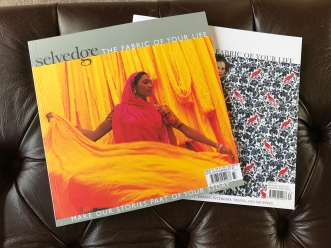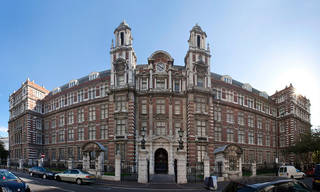Aim of this Exercise
This exercise is to find out more about your chosen textile pieces through observation and further research.
Dress 1 – Poinsettia
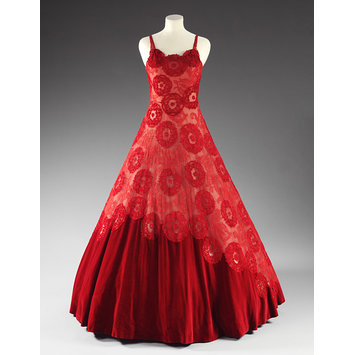
Photo of Dress from V&A

Photo of Angele Delanghe, from http://www.en.wikipedia.org/wiki/Angele_Delanghe
As a London based designer Angele was born in Belgium and moved to the UK in 1914 as a refugee. Her first collection was shown in 1939 and she was known for her soft tailoring techniques. By 1949 she was designing for Fortnum and Mason. The Red Poinsettia dress was made in 1953. Angele Delanghe died on 27th May 1971.
The dress was worn by Lady Alice Makins (wife of Sir Roger Makins – the British Ambassador in Washington 1953-1956. Lady Makins requested straps be added to the oringinal dress and was thought this was requested as she loved dancing and the dress would be safer with straps. The dress was inherited by her daughter Mary (the Viscountess of Norwich).
The V&A received this dress as a gift from the Viscountess of Norwich
This red lace ball gown was the first dress that I looked at and I spent far too long on it sketching and trying to work out how the chenille effect was made. This left me with not as much time on the other dresses.
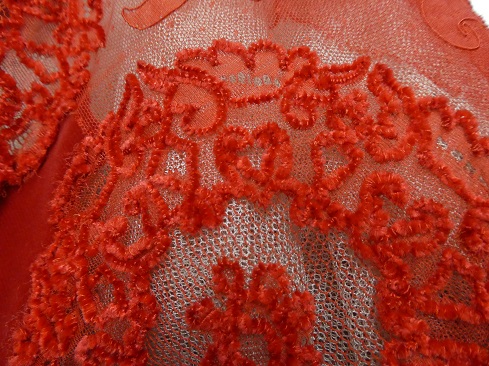
Close up of the lovely chenille design
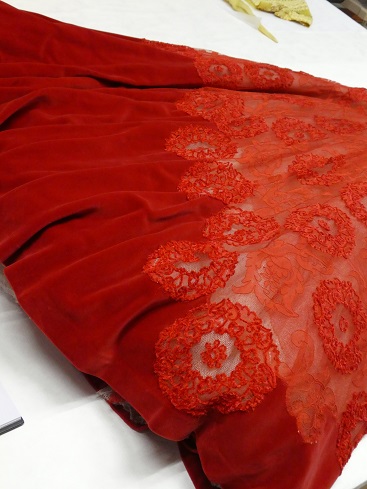
Rich Red Velvet cut out as the bottom part of the dress.
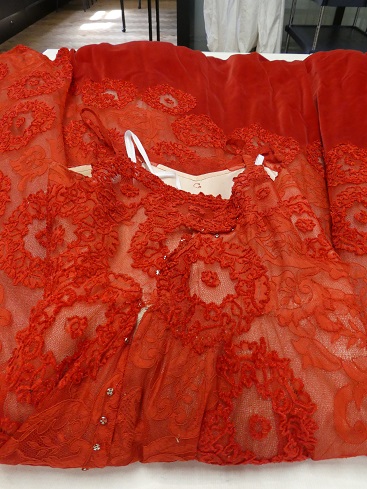
I was quite intrigued by how the dress was done up at the back, the pop studs and hook and eyes followed the pattern of the circles.
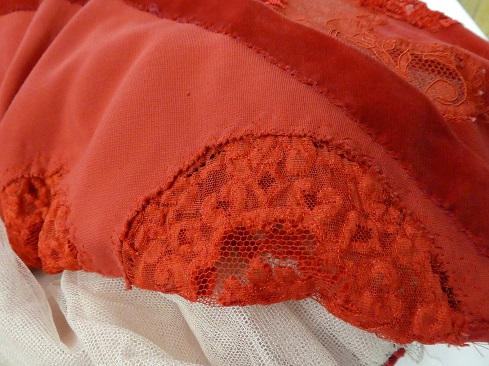
Close up of the cut out Velvet and the hand stitching of the chenille circle design on the netting, from behind you can see that the chenille pattern has been machine stitched into place over the red net to create the beautiful design.
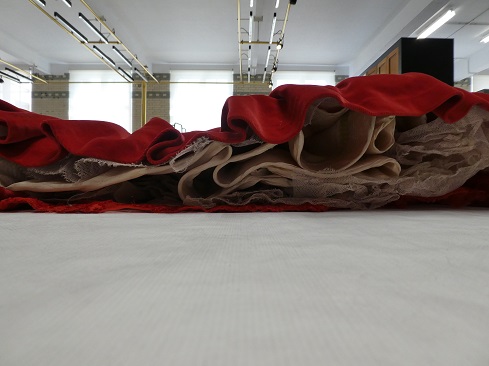
I can see some lovely lines here in this picture from the petticoats and velvet. The petticoat consists of a satin outer, hemmed with crinoline and layers of pink net to form a more fuller underskirt.
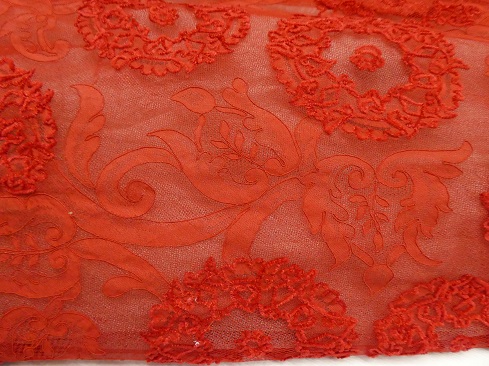
Pretty lace design

From this photo you can see the two layers of net that show that the chenille circles and the gupiere design are different pieces of net stitched together (this piece has come apart)
From the above photos, you can see that there are some holes and rips in the dress and on the velvet I could also see drink stains. The dress looks like it has been worn quite a few times from the stains and dirt on it. I can just see Lady Makins and her husband Waltzing around a ballroom maybe at the Blackpool Tower Ballroom.
The curator and I were quite intrigued as to why there was a pin still in the lining of the dress, I would assume that it had been there since the making of the dress due to type of pin. There wasn’t a makers label for this nor any care instructions but would imagine it would require dry cleaning, due the velvet and delicate lace.
I am a seamstress and to me the make up of the dress was an eye opener. I have always been taught to finish the seams off neatly, the cutting of the selvedge edge is unusual as these days we always cut this off and either overlock it or finish with different type of seam. The way the additional straps have been added looks like it was quick and simple method of attaching them as it looks as though they have just been sewn on to the bodice and the placement of the round chenille design place over the top to hide the stitching.
Dress 2 – Evening Ensemble – La Ligne Muguet
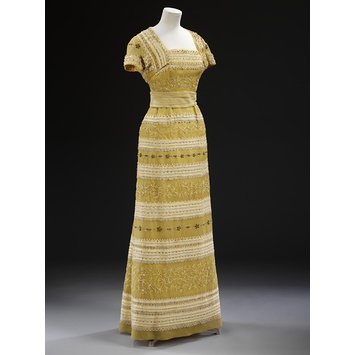 Image from V&A
Image from V&A
This dress was given to the V&A by Mrs Loel Guinness
The dress was made around 1954, and was designed by Christian Dior, born 1905 died 1957
This dress was a special commission designed and made by Christian Dior for Gloria Guinness (1912-1980) and was given to the Museum as part of the Beaton gift in 1971.
In 1962 Gloria Guinness was voted 2nd ‘Best dressed woman’ by the Time magazine. Gloria had 7 homes where she kept a full wardrobe saving the need to pack each time she visited. Gloria also patronised many couture houses, she was married three times and her last husband Thomas Loel Guinness was a member of parliament and an heir to the Guinness beer fortune, he died in 1989.
The 3 piece set comprises of a full length evening dress which is strapless and has a straight skirt, a Bolero and a cummerbund belt. All parts of the dress were made with silk organza, decorated with alternating horizontal bands of beading, sequins and ribbon. Panels of beads and embroidery worked in a metal thread are placed between the ribbon and embroidery panels. The lining is made of a cotton and net and is also boned.
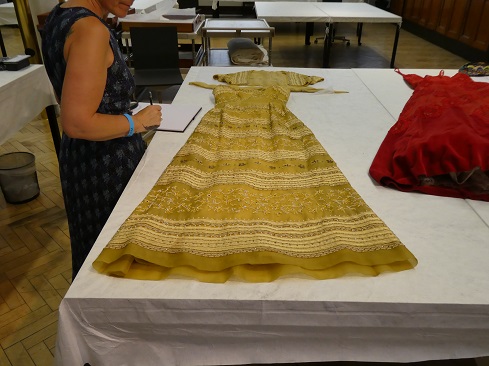
Myself looking at the Dior dress and thinking were to start on my drawings
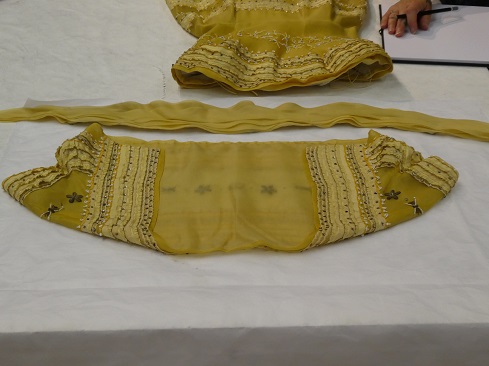
Layout of the three pieces of the Ensemble
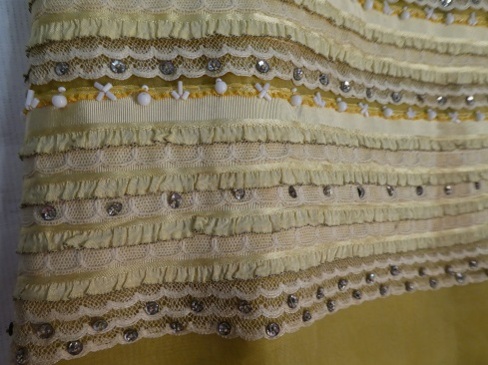
Close up of the layers of ribbon, beads and sequins

Love this image of the close up of the inner and outer together
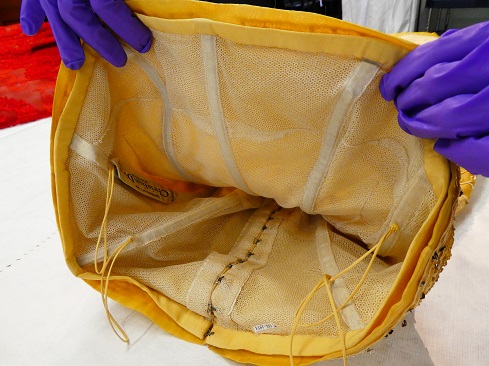
You can see the Christian Dior label and you can tell, that this a Haute Couture dress by the way it had been put together. The Inner part of the bodice is secured by Hook and eyes. The inner lining is made with a thin net which on close inspection looked quite rough and to wear this looked like it may be uncomfortable unless you were wearing an undergarment.
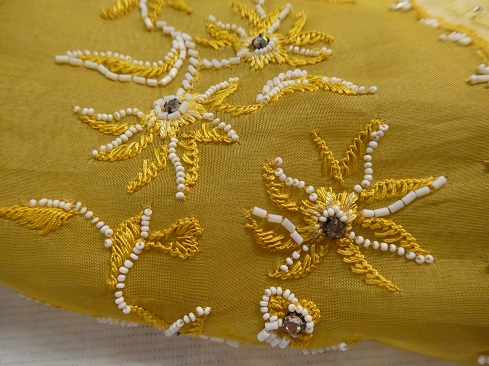
Close up of the hand embroidery and beading positioned in a couple of panels on the dress. Mrs Guinness had the skirt lengthened, which would have been quite expensive to do, as it was very time consuming and there was so much of it. The centre Gem I would have thought would be ‘Swarovski’ as I don’t think Dior would have used a cheaper version.

As you can see three of the beads have come off and this appears in most of these little embroidery and beaded patterns. There were also a few holes in the fabric and these were mainly where beads had been present. But the fabric in all was in quite good condition and wasn’t very dirty so must have been cleaned at some point. Embroidery was a theme of Christian Dior and I would like to look further into more of his collections.
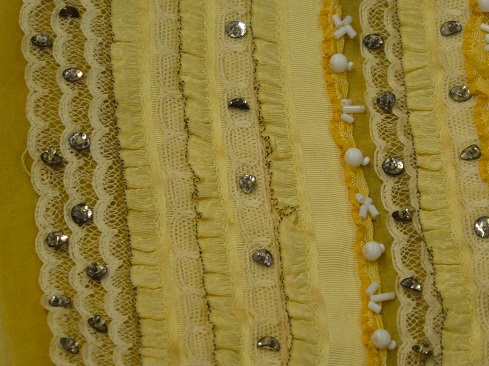
Close up of the ribbon, for which there are quite a few layers of different types beads and sequins, a lot of the sequins have become squashed and bent which I found strange and can only imagine that as these are on the front and back of the dress this has happened through the storage or cleaning process.
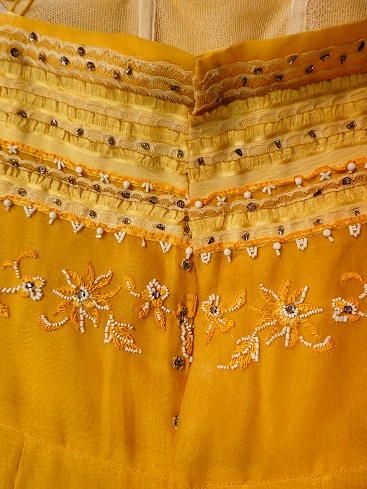
The back opening is similar to the inner with hook and eyes to close the dress up (instead of a zip) with pop studs further down on the silk organza
Dress 3 – Evening Dress
– 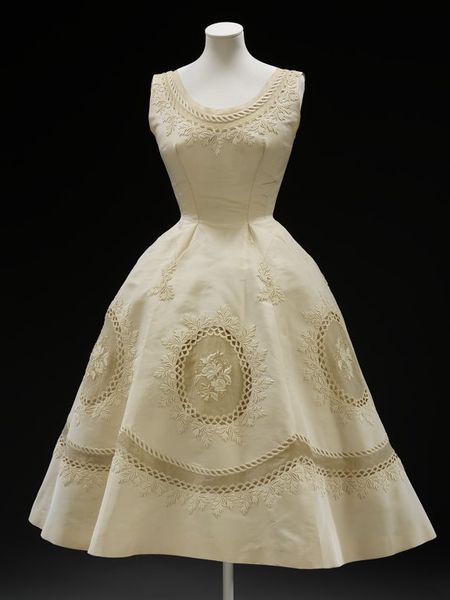
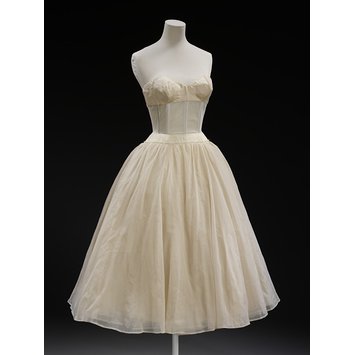
Images from V&A
The petticoat wasn’t available to view but from the information I could find it was made of net, boned and the care given to making it was same as the outer dress.
The designer Pierre Alexandre Claudius Balmain was born on 18th May 1914 in Savoie in France and died of liver cancer on 29th June 1982 in Paris. His father died when he was seven years old and his mother at the time worked in a fashion boutique. In the mid 1930’s he joined Lucien Lelong who was a French couturier. This is where Balmain met Christian Dior and where he trained alongside him. Balmain became a well known couturier of his generation and his house employed a large number of workers (600), he also had 12 couture workrooms and also had fur and millinery arteliers working for him. He also designed costumes for 16 films including ‘La Parisienne’. He was also known by Royalty, the Queen of Thailand had her wardrobe designed by Balmain for her Tour of America in 1960 and the Duchess of Windsor also chose outfits from his collection in his early years.
The lemon Evening dress was made in Paris between 1950 and 1955 and was made out of silk. There is some lovely cut-work in the oval sections of the dress and looking closer the outer edging has been hand stitched onto the dress. Each piece of the gupierre lace flowers have been stitched on by hand too along with the rope edging.
As you can see from the last photograph, there is some discolouration in the fabric and this seemed to be only around the top part of the dress. There was no makers label in the dress and no care instructions. The dress also had marks on the front of the skirt and sweat marks under the arms. The dress doesn’t look like it has been worn much, as there was no sign of rips/tears, and obviously not been cleaned before being given to the V&A by Mrs G Sachet who wore the dress. The dress has been well made and there were no signs of any alterations.
I had the chance to look at another dress, but didn’t have time to look at it more closely but would like to share some photos I took as it still had some lovely block printing patterns on it
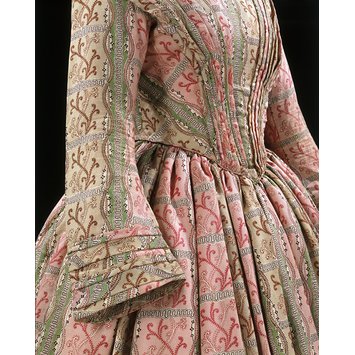 Made in Great Britain in 1848-1850. Designer and maker is unknown, donated to the V&A by Messers Harrods Ltd.
Made in Great Britain in 1848-1850. Designer and maker is unknown, donated to the V&A by Messers Harrods Ltd.
This beautiful block printed day dress has some very delicate and pretty scrolling shapes printed on it. It is described to be made of wool (with a cotton lining) but to me looks more like a heavyweight cotton. The design is said to reflect the Mid Victorian era of rococo design. As one of the four dresses I looked at this one has some lovely binding to it especially at the seams around the neck, waist and the sleeves. The bodice (which is boned with whale bone) has tiny pleats around the bust area from the shoulders pointing down to the tiny waistline which has been self bound. For a dress of this age it has been made well and to last as would have been worn in the day. There were no signs of alterations and no rips or holes in it, just a little grubby at the hem line which you would expect.
Of the four dresses above this one to me is best made dress, even though it is only a block print the dress itself is made to a very high standard. Perhaps because of the nature of how it was worn it needed to withstand everyday wear that it had strong bound seams. Looking at the period of dress for the 1840’s, many of the dresses take on this shape of a tiny waist with a bodice with pleats pointing to the centre waistline. If I had the time again to view these dresses I would have looked further into the one above. Because of its age I feel that this has more of a historical feel to it and I can place myself in this era and would love to have worn this dress.
It is a shame that when items are given to the archive department that more details are not given regarding when the dress would have been worn with perhaps a picture of the person wearing it. I suppose in our day to day life we take photographs of everything because we have a cameras on our phones and it is easy to just press a button. I think that this research has made me realise that taking photos of anything and everything is a great thing to do, its how we remember and how we can document items for the future generations.
















 Image from V&A
Image from V&A















 Made in Great Britain in 1848-1850. Designer and maker is unknown, donated to the V&A by Messers Harrods Ltd.
Made in Great Britain in 1848-1850. Designer and maker is unknown, donated to the V&A by Messers Harrods Ltd.




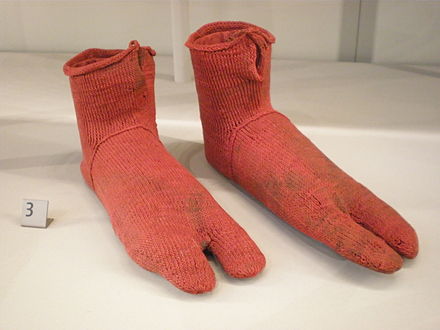 Nalebound socks from Egypt (300-500 AD)
Nalebound socks from Egypt (300-500 AD) Mittens done in “nalebinding”
Mittens done in “nalebinding”






